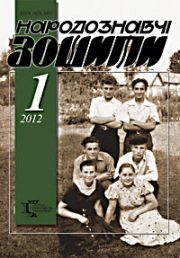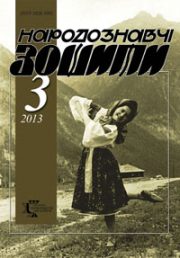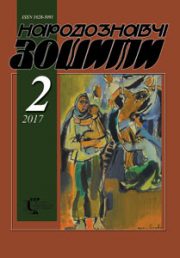The Ethnology Notebooks. 2023. № 2 (170), 386—395
UDK7.04.011.26(477.43/.44)”19/20″:[39(=161.2):728.6]
DOI https://doi.org/10.15407/nz2023.02.386
REGARDING THE USE OF THE TERM «DOMESTIC ICONOSTASIS»
TRISKA Oksana
- ORCID ID: https://orcid.org/0000-0002-4717-4396
- Ph.D, Art History Researcher at Folk Art Department
- of Ethnology Institute of the National Academy of Sciences of Ukraine,
- 15, Svobody ave., 79000, Lviv, Ukraine,
- Contacts: e-mail: oksana_triska@yahoo.de
Abstract. Decorating homes with a large number of icons was characteristic of most regions of Ukraine-Rus’. This trend is evidenced by photos of rural housing from the last quarter of the 19th — early 20th centuries. The article examines the spread of home icon complexes, which included multi-plot works.
The purpose of the article is to explain the emergence and introduction of the term domestic iconostasis, to substantiate its semantic connotations, appropriateness of use and to reveal the specifics of the works to which it refers. The object of the study is the iconographic heritage of the folk painters of Podillia (works from private and museum collections of Ukraine). The subject of the study is iconographic features, the principles of creating multi-plot icons as a certain unique manifestation of folk creativity. The territorial boundaries refer to the territory of Eastern Podillia (the place of discovery of the majority of multi-plot samples), for comparison, the traditions of domestic icon painting throughout Ukraine are taken into account. Chronological limits — the period of the heyday of the phenomenon in the above-mentioned time period.
The article uses: the historical method — for the chronology of the spread of domestic icons, the comparative-historical method — for the comparison of regional traditions. Most of the research is based on iconographic and comparative analysis.
The scientific novelty of the research consists in examining the structure of multi-plot household icons and revealing the principles of their construction: with and without hierarchical subordination to the main plot. For the first time, the research traced the formation of the principles of folk iconography and their use in Podillia multi-plot icons on canvas.
Conclusions. The term domestic iconostasis is a conditional and variable name that does not mean a stable theological structure and indicates a selection of icons for homes popular in each region. Usually, this is an image of Christ, Virgin Mary and Child, patron saints and various multi-figure subjects. This term does not imply the iconographic identity of household and church icons. However, like the church iconostasis, the home iconostasis sacralized the place and the home, served as a prayer object and performed a didactic function. This term should also be applied to multi-plot icons on which three or more themes are reproduced. Its importance is deepened by the such icons of Podillia, testifying to the originality of the folk religious worldview, the local iconographic specificity and the compositional ingenuity of the folk painters.
Keywords: domestic icon, folk iconography, multi-plot works, composition principles, folk painter, domestic iconostasis, folk tradition.
Received 28.02.2023
REFERENCES
- Aleppo of Paul. (1985). The journey of the Patriarch of Antioch Macarius: fragments. Universe, 12 [in Ukrainian].
- Sichinskyi, V. Strangers about Ukraine. Retrieved from: http://zounb.zp.ua/resourse/scarbnicya/chuzhinci/indexf.html (Last accessed: 03/02/2023) [in Ukrainian].
- (1901). Works of the Podilsk Diocesan Historical and Statistical Committee under the editorship of E. Sesinsky. Parishes and churches of the Podilsk eparchy (Issue 9). Kamyanets-Podilsk [in Russian].
- Kotsyubynskyi, M. On faith. Retrieved from: https://www.ukrlib.com.ua/books/printit.php?tid=2537&page=8 (Last accessed: 06/02/2023) [in Ukrainian].
- Nechuy-Levytskyi, I.S. (1977). Works: in 2 vols. Old world fathers and mothers (Vol. 2). Kyiv [in Ukrainian].
- Yavorovsky, M.I. (1880). The house of a wealthy Podilsky priest and room decorations in the taste of the past century. PEV, 3 [in Russian].
- Sherotsky, K. (1914). Essays on the history of decorative art of Ukraine. 1. Artistic decoration of the house in the past and present. Kyiv [in Russian].
- Stepovyk, D. (2019). Stained glass windows of Adam Stalyony-Dobzhansky: to the question of the approchement of Catholic Christian art with Orthodox. Modern Ukrainian decorative art: preservation of national identity in the conditions of globalization (Pp. 214—226). Kyiv [in Ukrainian].
- Zilinko, R. Formation and structure of the Ukrainian iconostasis. Retrieved from: https://www.osbm.org.ua/index.php/publikatsiyi/liturhiya/1835-formuvannia-i-struktura-ukrainskoho-ikonostasa (Last accessed: 02/02/2023) [in Ukrainian].
- Stepovyk, D. (2003). Iconology and iconography. Ivano-Frankivsk [in Ukrainian].
- Bogomolets, O. (2017). Ukrainian domestic icon. Kyiv [in Ukrainian].
- Nayden, O. (2009). The folk icon of the Central Dnipro region in the context of the peasant cultural space. Kyiv [in Ukrainian].
- Yesyunin, S. Construction of typical regimental temples in the deployment area of the 12th Army Corps at the end of the 19th — early 20th centuries. Retrieved from: https://www.religio.org.ua (Last accessed: 02/02/2023) [in Ukrainian].
- Romaniv-Triska, O. (2015). Coronation of the Virgin Mary. People’s Icon of Chernihiv Region. Lviv [in Ukrainian].
- Lykhach, L., & Kornienko, M. (2000). Icons of the Shevchenko region. Kyiv [in Ukrainian].
- Zhurunova, T. Secrets of the face of a saint with a controversial reputation: how Podolians saw Mary Magdalene, 08.08. 2020. Retrieved from: https://www.ukrinform.ua/rubric-regions/3077354-sekreti-liku-svatoi-iz-supereclivou-reputacieu.html (Last accessed: 02/02/2023) [in Ukrainian].
- Zhaivoronok, V.V. (2006). Signs of Ukrainian ethnoculture: Dictionary-reference (Pp. 659—660). Kyiv [in Ukrainian].






